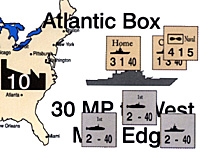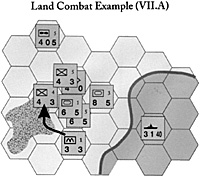 Convoy Attack Example (IV.B)
Convoy Attack Example (IV.B)
Summer 1941
The Allied player has placed both the British Home and Channel fleets in the portion of the Atlantic box containing a ship symbol. The Allies announce that three Lend Lease points will be sent to Britain. The British 'Naval" air unit is aboard the Channel fleet, so it can help defend against an Axis convoy attack.
The Axis has the 1st and 2nd German submarine fleets plus a German surface fleet in the Atlantic box. The Convoy Attack is resolved first. The Axis fires 7 factors on the Convoy Attack line. On a roll of 3, the Allies suffer 2 loss points.
The Axis chooses to eliminate 2 Lend Lease points, leaving Britain with 4 points: 1 Lend Lease, 2 for Dominions, 1 for Iraq (which has not yet revolted). Combat between the fleets is resolved next.
The Allies fire on the German fleets with 8 regular combat factors. A die roll of 6 on the "7-9" column for "Sea vs. Sea" yields 2 loss points. (Had there been only Axis subs, the Allies would have fired with 5 ASW factors on the "5" column on the "ASW" line, producing the same result.)
The Axis fires back with 7 factors on the same 7-9 column; a die roll of 5 produces 2 loss points. Since both sides have the same loss points and the Allies were the high roller, the Axis must retreat all its units.
The Axis decides to flip the surface fleet over and places all the fleets in the nearest Axis controlled port from the west map edge of its choice (in this case hex 1703, Oslo, Norway). The Allies flip the Home fleet and the naval unit aboard the Channel fleet to cover its losses.
If this convoy attack had occurred on or after Winter 1943, the Allied ASW attack would have occurred first. Assuming identical results, all the Axis fleets would have been forced to retreat before performing the intended Convoy Attack. No Allied production points in the Atlantic box would have been lost.
 Bombing Example
Bombing Example
German 2d and 5th air units are assigned to bomb Allied city A. The Allies select the US 9th air unit to intercept. Air-to-air combat is resolved first. The Allies have a total combat value of 4. A die is rolled and cross -referenced with the 3-4 column of the Air vs. Air row of the Combat Chart. A die roll of 3 produces one loss point.
The Axis bombers fire back at half strength with 4 factors, rolling a 2 on the die, which causes no losses. The Axis decides to flip 2d air unit to its reduced side to cover the loss point caused by Allied interception. There is no retreat.
The bombing force now has 6 combat factors. No shift right occurs because no strategic units (range: 6) are involved. A die is rolled and cross-referenced with the 5-8 column on the "Bombing" row. The die roll is 4, resulting in no effect. Had the roll been a 5 or 6, the Allied player would have lost a production point during this game turn's Production.
Airdrops (VI.A.1)
A paratroop unit may move normally by land, or instead it may make an airdrop. The paratroop unit moves up to three hexes, ignoring terrain, enemy units, and enemy ZOC. It cannot end an airdrop in an all-sea hex, but it may land on top of an enemy unit (II.F.3).
Rail Movement (VI.A.2)
A land or air unit moves by rail when it does not begin in an enemy land unit's ZOC and does not enter one throughout its entire move during a friendly player turn. A unit transported by sea that lands in a friendly port may then use rail movement. Rail movement is not allowed during Armored Action. A unit moving by rail can enter as many hexes as it wishes, as long as each hex entered is:
- Land or coastal terrain
- Free of enemy land ZOC
- Not in a neutral country
- Outside of Spanish Morocco (1015 and 1116), French N. Africa, Tunisia, Libya, and Persia
 Land Combat Example
Land Combat Example
It is the Allied player turn. In the movement phase, the US paratroop unit airdrops onto the German 4th infantry. US 1st armor combines with the paratroop unit in the combat phase to attack 4th German. The Axis chooses not to use the German 5th air unit in support. Both players then count up their total combat factors, and each rolls a die.
The US has 9 total factors, but is shifted to the 4- 7 column on the Land vs. Land row of the CRT because the defender occupies a forest hex. A die roll of 4 yields one loss point.
The German has 4 combat factors and rolls a 2 on the 4-7 column, causing no losses. The German unit must flip to its reduced side and retreat one hex. The US 1st armor can advance into the vacated hex.
Next, the Allied player uses 3d and 5th armored units to attack the 5th German infantry and the fort it occupies. The Allied surface fleet unit provides support. The Axis chooses the unrotated 5th air unit for defensive support, which has not yet fought this turn. The support units first fight each other using the 4-6 column of the Air vs. Sea line for the air unit's fire, and the 1-3 column of the Sea vs. Air line for the fleet's fire.
The Axis air unit rolls a 5 and scores a hit, and the Allied fleet rolls a 2 for no effect. The fleet flips to its reduced side, rotates 180 degrees, and retreats to the nearest Allied- controlled port. The air unit adds to the Axis land strength for a total of 12, and the Allies have 14 on the Land vs. Land line. The Axis rolls a 4 on the 9-12 column for 1 loss point, and the Allies roll a 5 on the 13-16 column for 2 points.
The German fort must absorb the loss points and is destroyed, so the 5th German must retreat. The Allied decides to reduce 3d armor and may advance with one or both armor units into the vacated hex.
Amphibious Landing (VI.A.3)
1. A unit aboard a fleet may be landed on any coast hex the fleet can reach that contains no enemy fleets. It costs nothing for the fleet to drop off its passenger, and the fleet may continue on its way if the owner wishes.
2. If the unit lands at a friendly- controlled port, it may continue moving on land normally, up to its full movement factor (or double its range for air unit'). The unit may use rail movement. A unit may move no further if it lands in any non- port hex. 3. Units landing in any hex of a neutral country triggers an invasion (II.G.1). If the target hex is in an enemy-controlled country, an amphibious assault must occur.
Amphibious Assault (VI.A.4)
1. Units obey all Amphibious Landing rules (V.A.3) and may move no more than five hexes to an enemy-controlled port hex.
2. If the landing hex is occupied by any enemy land units, conduct a normal land combat after displacing enemy fleets and air units (II.E.1).
3. If the target hex contains no enemy land units, perform displacement and then determine enemy strength in the hex as follows. One artillery, two other land units, and any unrotatcd fleets and air units that exert a ZOC into the target hex contribute half their normal strength to the combat. If no land units qualify, treat the hex as having a strength of one factor.
4. Resolve land combat normally. Follow Resolving Combat on the Detailed Sequence of Play. Perform retreat normally if the defender loses, and use the special overstacking procedure (II.F.3) if the attacker loses.
Transit Attack (VI.C.5)
1. When a fleet unit or stack of units moves or retreats into the ZOC of any enemy fleets and air units, some or all of the enemy units may attack. Air units must be ready for action (not rotated).
2. Once the attackers are chosen, the defender may select unrotated air units with a range of 3 that exert a ZOC into the target hex. Air units resolve combat (without moving) on the Air vs. Air line of the Combat Chart. Follow the procedure under Resolving Combat in the Detailed Sequence of Play.
3. The side that wins the air battle adds its surviving strength to friendly fleet strength or fires by itself if there are no friendly fleets present. See Resolving Combat.
4. A moving fleet not forced to retreat and rotate 180 degrees may resume movement if the owner wishes and it has any of its movement factor remaining.
Back to Table of Contents GameFix # 7
Back to Competitive Edge List of Issues
Back to Master Magazine List
© Copyright 1995 by One Small Step, Inc.
This article appears in MagWeb.com (Magazine Web) on the Internet World Wide Web.
Other articles from military history and related magazines are available at http://www.magweb.com